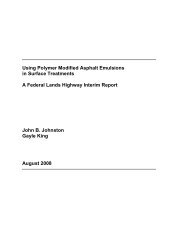Spray Applied Polymer Surface Seals - TSP2
Spray Applied Polymer Surface Seals - TSP2
Spray Applied Polymer Surface Seals - TSP2
You also want an ePaper? Increase the reach of your titles
YUMPU automatically turns print PDFs into web optimized ePapers that Google loves.
Recommendations for Future Study<br />
Not in scope of study:<br />
• Simple, reliable field permeability test<br />
• Develop relationship between emulsion<br />
rheology and infiltration<br />
• Define procedure for optimal application<br />
rates<br />
• Verify if pay-item test strip improves<br />
performance and safety<br />
• Define sand quality for best friction<br />
• Performance-related specifications needed<br />
to characterize the multitude of products<br />
CONCLUSIONS AND RECOMMENDATIONS<br />
The state surveys, field trials and test results in this study demonstrate that fog and rejuvenator sealers are inexpensive and<br />
effective treatments for providing protection to pavements and prolonging pavement life. The primary constraint to the use of<br />
sealers on dense HMA mixes is a loss in friction following application. Sanding and strict traffic control until friction returns to<br />
a specified level can mitigate the problem. The easily portable Dynamic Friction Tester and Circular Texture Meters are<br />
useful devices for quick and repeatable field friction testing. <strong>Seals</strong> can also significantly prolong the life of seal coats, opengraded<br />
mixes and shoulders. Specific conclusions for timing, construction and testing may be found above in the Results<br />
and Discussion section, but it is recommended that a test strip be a pay item to correctly identify shot rates, equipment<br />
calibration and cure time for return to traffic before the project.<br />
There were several topics beyond the scope of this project that warrant further study. They include:<br />
Developing a simpler, more effective field permeability test applicable to fog seals;<br />
Developing relationships between emulsion properties (surface tension, particle size, viscosity) and pavement permeability<br />
which can predict infiltration of the emulsions into the pavement surface;<br />
Defining a procedure for determining optimum application rates;<br />
Verifying if a pay-item test strip can improve performance and safety;<br />
Defining sand quality including angularity and maximum moisture content; and<br />
Understanding whether vehicle control on newly sealed sections is adequately predicted by IFI. While the test results<br />
showed higher friction on some of the rejuvenator-treated sections, walking, driving and braking on those sections seemed to<br />
show that the surfaces were more slippery than the test results indicated.<br />
Specification writing was also outside of the scope of this study. However, it is strongly recommended that performancerelated<br />
specifications be developed, and it is hoped the results of this study will be useful in that endeavor. Some ideas<br />
generated here include defining desired physical properties of the surface following application, defining emulsion residue<br />
properties in mechanical or physical chemical terms for an emulsion purchase specification, and defining parameters that<br />
impact emulsion infiltration into the pavement, such as emulsion surface tension, particle size and viscosity. Also, there<br />
should be definition and specification of construction criteria such as application rates in terms of coverage and decrease in<br />
surface permeability, and release to traffic based on minimum friction index, break time and no tracking of material.<br />
The final task of this study is dissemination of the information. The posting of the results on the internet (10) is being<br />
supplemented with workshops at several Pavement Preservation Partnership regional meetings in 2007 and 2008.<br />
102
















